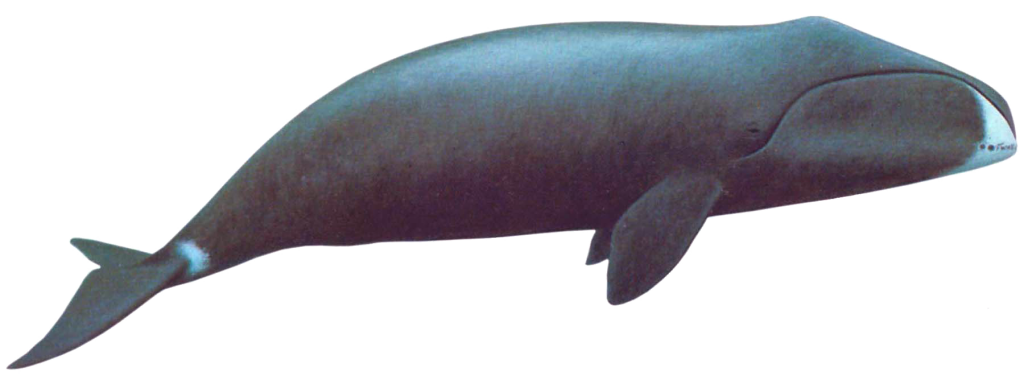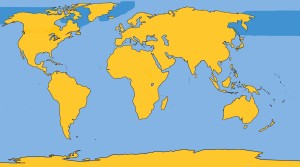
Family: Balaenidae
Genus: Balaena
Species: B. mysticetus Linnaeus, 1758
Bowhead whales inhabit only arctic waters, where they follow the seasonal advance and retreat of the ice edge. Their populations have been severely reduced by whaling, making them the most endangered of all large whales. Their commercial value lay not only in a large yield of oil (70 to 90 barrels), but in baleen as well, for the manufacture of corsets and household brushes before the development of plastics. Bowheads were protected from commercial whaling in 1946, but the International Whaling Commission permitted an unregulated subsistence kill by or on behalf of Eskimos until recent years. The IWC now regulates the Eskimo kill. The U.S. Marine Mammal Protection Act of 1972 also permitted subsistence hunting of these whales by Eskimos.
Their limited numbers and the harsh aquatic environment in which they live make them the most difficult of all whales to study.
Like other members of its family, the bowhead is a stocky animal whose head comprises nearly one-third of its total body length. Its baleen plates are the longest of all whales. The white patch occurring on the bottom lip of many animals is irregularly shaped and found only on this species. With no dorsal fin on its back, the bowhead is capable of breaking through new ice up to 12 in (30.5 cm) thick. This is why these whales are often accompanied by belugas, for the small white whales must seek out in the ice to breathe. Young bowheads remain submerged longer than the older animals. Whether this activity is a function of age, hierarchical feeding position in the group, or something else remains open to conjecture. Bowhead whales are known to leap high into the air, splashing on their sides upon re-entry. Unlike the other large right whale, bowhead whales often sink when killed.
Physical Description: They are the stockiest of all whales, with a very large head. The mouth is bowed upward more extremely than that of either of the other whales of this family. Paired nostrils are located on the rise of the forehead. Their smooth bodies are remarkable free of external parasites. The body tapers sharply along the peduncle to the flukes.
Color: Generally blue-black overall. Sloughing skin gives a mottled effect. Many individual animals display white coloration or patches randomly no the stomach region, lower jaw, and peduncle.
Fins and Flukes: They have no dorsal fin. The flippers are small compared to the body and somewhat paddle-shaped. Well-defined, well-spread flukes are pointed at the tips with a median notch.
Length and Weight: Adults reach 50 ft (15 m) and about 65 tons (60,000 kg); females are slightly larger.
Baleen Plates: There are 325 to 360 plates on each side of the upper jaw, 12 in (30 cm) wide and 14 ft (4.3 m) in length.
Feeding: Various small crustaceans are taken, including copepods, steropods, and mysids.
Breathing and Diving: Two to 6 breaths within a few minutes are followed by a longer dive averaging 15 minutes, although a dive has been known to last for up to an hour. The flukes are often raised high before a long dive, then the animal dives straight down and often returns to the point of departure. They have been reported by Eskimos to swim upside down. Two separate spouts rise 12 to 15 ft (3.7 to 4.5 m).
Mating and Breeding: An 11.5 to 18 ft (3.5 to 5.5 m) calf is born after a gestation period believed to be 10 months. Calves are weaned at six months. Mating takes place during April and May, although bowheads have been observed mating in the South Chukchi Sea n mid-June. Sexual maturity is attained at 38 ft (11.5 m) in males, 40 ft (12 m) in females. Calving takes place at 2-year intervals.
Herding: Individuals or groups up to 3 are found in spring; in autumn, loose groups of up to 50 may be observed.
Distribution: They are found in the Northern Hemisphere near the ice edge. They are indigenous to Arctic waters although their original range extended much farther south. They are currently located in four principal areas: (1) Spitzbergen, westward to east Greenland; (2) Davis Strait, Baffin Island, Hudson Bay, and adjacent waters; (3) Bering, Chukchi Sea, Beaufort, and east Siberian seas; (4) Okhotsk Sea.
Migration: Little is known of their migration. Some animals are found in Arctic waters in summer, moving south in their range as seas ice over.
Natural History Notes: Their lifespan may exceed 40 years.
BOWHEAD WHALE DISTRIBUTION







